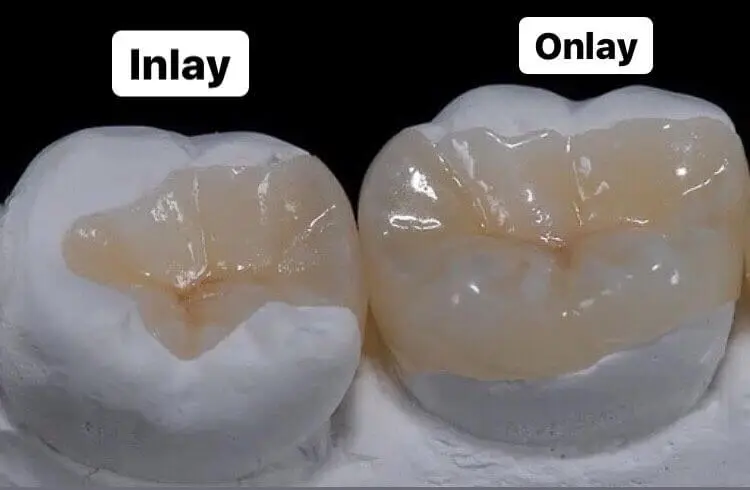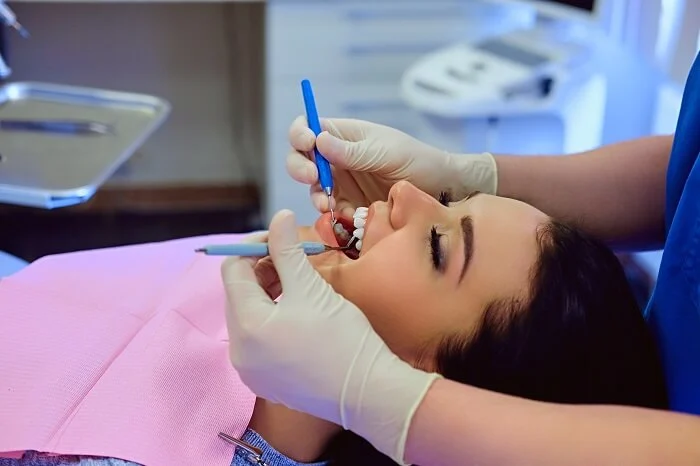Ceramic Inlays and Onlays in Dubai.
What is ceramic Inlay/ Onlay ?
Ceramic Inlays:
Ceramic inlays are a type of dental restoration used in the field of dentistry. They are specifically designed to repair and restore damaged or decayed teeth, providing an aesthetically pleasing and long-lasting solution.
Ceramic inlays are custom-made restorations that fit into the prepared cavity of a tooth. They are created using advanced dental technology, such as computer-aided design and computer-aided manufacturing (CAD/CAM), which ensures a precise fit and natural appearance.
The process of placing ceramic inlays typically involves the following steps:
Diagnosis and Treatment Planning: Your dentist will examine your tooth and determine whether a ceramic inlay is the appropriate treatment option. X-rays and dental impressions may be taken to assess the extent of damage.
Tooth Preparation: If a ceramic inlay is deemed suitable, your dentist will prepare the damaged tooth by removing the decayed or damaged portion. The tooth will be shaped to accommodate the ceramic inlay.
Impression: An impression or mold of the prepared tooth will be taken to create a custom-fit ceramic inlay. This can be done using traditional dental impressions or digitally with a scanner.
Temporary Restoration: While your ceramic inlay is being fabricated, a temporary restoration may be placed on the tooth to protect it.
Ceramic Inlay Placement: Once the ceramic inlay is ready, it will be bonded to the tooth using dental adhesive, Cementation should be under rubberdam isolation to prevent contamination with saliva and blood. Your dentist will ensure a precise fit and make any necessary adjustments to ensure proper bite alignment.
Final Polishing: After the ceramic inlay is securely bonded, your dentist will polish it to achieve a smooth and natural appearance that blends with your surrounding teeth.
Ceramic inlays offer several advantages over composite fillings. They are highly durable, resistant to staining, and can closely mimic the color and translucency of natural teeth, resulting in a more aesthetically pleasing restoration. Additionally, ceramic inlays are biocompatible, meaning they are well-tolerated by oral tissues and do not cause allergic reactions.

Ceramic Onlays:
Ceramic onlays, also known as porcelain onlays or ceramic overlays, are another type of dental restoration commonly used in dentistry. They are similar to ceramic inlays in terms of material and purpose, but they cover a larger portion of the tooth’s surface.
Ceramic onlays are designed to repair and restore teeth that have suffered significant damage or decay, extending beyond the area that can be treated with a traditional filling. They provide a conservative and aesthetically pleasing alternative to dental crowns, as they preserve more of the natural tooth structure.
The process of placing ceramic onlays involves several steps, similar to ceramic inlays:
Diagnosis and Treatment Planning: Your dentist will assess the condition of your tooth and determine whether a ceramic onlay is the most suitable treatment option. X-rays and dental impressions may be taken to evaluate the extent of damage.
Tooth Preparation: If a ceramic onlay is deemed appropriate, the damaged portion of the tooth will be removed, and the remaining tooth structure will be shaped to accommodate the onlay.
Impression: An impression or digital scan of the prepared tooth will be taken to create a custom-made ceramic onlay that precisely fits the tooth’s contours.
Temporary Restoration: While the ceramic onlay is being fabricated in a dental laboratory, a temporary restoration may be placed to protect the tooth.
Ceramic Onlay Placement: Once the ceramic onlay is ready, it will be bonded to the tooth using dental adhesive. Your dentist will ensure a proper fit, bite alignment, and adjust the onlay if necessary.
Final Polishing: After the ceramic onlay is securely bonded, your dentist will polish it to achieve a smooth and natural appearance that blends with your surrounding teeth.
Ceramic onlays offer several advantages. They are highly durable, resistant to staining, and can closely match the color and translucency of natural teeth, resulting in a seamless and esthetically pleasing restoration. By preserving more of the natural tooth structure, ceramic onlays help maintain the tooth’s strength and integrity.
Material Made of:
Ceramic inlays can be made from different materials, each with its own characteristics and advantages. Here are some common materials used for ceramic inlays:
1.Lithium Disilicate: Emax – Lithium disilicate it is a material of choice, it is a type of glass-ceramic material known for its strength and durability. It provides excellent esthetics and can be used for both anterior (front) and posterior (back) teeth. Lithium disilicate inlays are highly resistant to wear and can withstand chewing forces.
2.Zirconia: Zirconia is a strong and biocompatible ceramic material that has gained popularity in dentistry. It offers exceptional strength and durability, making it suitable for inlays. Zirconia inlays are known for their longevity and resistance to fracture.
3.Composite Ceramic: Composite ceramic materials combine ceramic particles with resin-based materials. They offer good esthetics and can be color-matched to natural teeth. Composite ceramic inlays are more conservative in tooth preparation and can be placed in a single appointment using chairside CAD/CAM technology.
The choice of material for ceramic inlays depends on various factors, including the location of the tooth, the extent of damage, and the desired esthetics. Your dentist will consider these factors and recommend the most appropriate material for your specific case.
Comparison with Dental Composites:
Ceramic inlays and dental composites are both dental restorative materials, but they have some notable differences. Here’s a comparison between ceramic inlays and dental composites:
1. Material Composition: Ceramic inlays are made of ceramic or porcelain materials, while dental composites are a mixture of resin and filler particles. The composition of ceramic inlays gives them superior aesthetics and the ability to closely mimic natural tooth color and translucency. Dental composites can also be color-matched to teeth, but they may not achieve the same level of esthetics as ceramic inlays.
2. Strength and Durability: Ceramic inlays are known for their strength and durability. They are highly resistant to wear and can withstand chewing forces, making them suitable for both anterior and posterior teeth. Dental composites are generally less durable compared to ceramics, and they may be more prone to wear and staining over time. However, advancements in composite materials have improved their strength and longevity.
3. Tooth Preparation: Ceramic inlays require more extensive tooth preparation compared to dental composites. To accommodate a ceramic inlay, a conservative amount of tooth structure needs to be removed. In contrast, dental composites allow for more conservative preparations, as they can be bonded directly to the tooth surface with minimal removal of healthy tooth structure.
4. Fabrication Process: Ceramic inlays are custom-made restorations that are fabricated in a dental laboratory. They are created based on impressions or digital scans of the prepared tooth. Dental composites, on the other hand, are directly placed and shaped on the tooth by the dentist in a single appointment.
5. Aesthetics: Ceramic inlays are highly esthetic and can closely match the natural color and translucency of teeth, resulting in a seamless and natural appearance. Dental composites can also be color-matched to teeth, but the esthetic outcome may be influenced by factors such as the skill of the dentist and the limitations of the material.
6. Cost: Ceramic inlays are generally more expensive than dental composites. The higher cost is due to the custom fabrication process involved with ceramic inlays and the superior esthetics they offer. Dental composites are usually more affordable, making them a popular choice for individuals seeking a more budget-friendly option.
Procedure of Fabrication:
The fabrication of ceramic inlays typically involves several steps, including dental impressions, laboratory work, and bonding, it is a one or 2 visits procedure depends on the technology that the clinic has. Here is a general overview of the procedure:
1.Tooth Preparation: The first step is to prepare the damaged or decayed tooth to accommodate the ceramic inlay. This involves removing the affected areas of the tooth and shaping it to create space for the restoration. The preparation ensures a precise fit and proper bonding of the ceramic inlay.
2.Dental Impression: Once the tooth is prepared, a dental impression is taken. This involves placing a tray with a putty-like material over the tooth and allowing it to set. The impression captures the exact shape and size of the prepared tooth and the adjacent teeth. Alternatively, digital scans of the tooth may be taken using a specialized scanner.
3.Temporary Restoration: While the ceramic inlay is being fabricated in a dental laboratory, a temporary restoration may be placed on the tooth to protect it and maintain its shape and function.
4.Laboratory Work: The dental impression or digital scan is sent to a dental laboratory, where skilled technicians will use it as a guide to create a custom ceramic inlay. Using computer-aided design and computer-aided manufacturing (CAD/CAM) technology, a digital model of the inlay is generated. Then, the ceramic material is milled or layered to achieve the desired shape, size, and color of the inlay. The ceramic is carefully crafted to ensure proper fit and aesthetics.
Why ceramic onlays are much more expensive than regular direct composite fillings?
They are technique sensitive , requires special materials , requires high end technology , needs qualified dentist.
In conclusion, ceramic inlays are an aesthetically pleasing, durable, and biocompatible option for the restoration of damaged or decayed teeth. They provide a natural-looking result, excellent longevity, and minimal impact on oral health. However, it is always recommended to consult with a qualified dentist who can evaluate your specific dental needs and provide personalized recommendations.
Our Expert Doctor

Dr. Sireen Shraim
Experiance: 4+ Years
Primary Speciality : General & Cosmetic Dentist
Dr. Sireen Shraim is a general and cosmetic dentist, with a work experience of more than 4 years in the UAE (Dubai), and 3 years in Palestine.
Positive, optimistic, energetic, decision maker, team worker, fast learner,
creative, responsible, resilient and professional.
Digital Smile design and smile makeover, using veneers and crowns and gingival management (gingivectomy and crown lengthening), preparing, temporizing and cementing all types of veneers depending on the patients’ needs.
You may like to read: Is Mouthwash Necessary? A Comprehensive Guide to Oral Health. Read Now.



